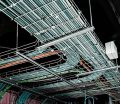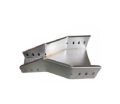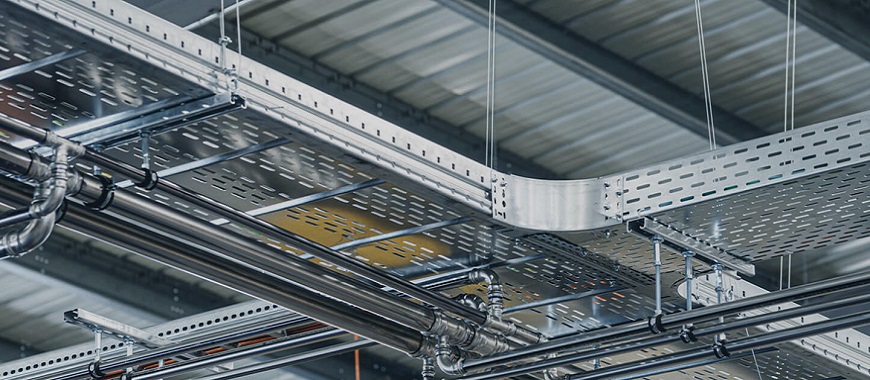
A cable tray risk assessment is an essential process in ensuring the safe installation and operation of cable management systems. Cable tray risk assessment evaluates hazard identification, installation and trucking risks, overloading dangers to supports and persons. By conducting a thorough risk assessment, potential hazards such as electrical faults, fire risks, or structural weaknesses in the cable tray work environment can be identified and mitigated before installation. This proactive approach helps in creating a safe working environment and preventing accidents that may arise from improperly installed or maintained cable trays. The cable tray risk assessment also evaluates environmental factors that could impact the system’s performance, such as exposure to moisture, extreme temperatures, or corrosive substances. By addressing these risks early on, organizations can implement appropriate safety measures, ensuring both the durability of the system and the safety of the workers and equipment it serves.
How about the Cable Tray Risk Assessment Process?
A cable tray risk assessment is a critical procedure that helps identify potential hazards and safety concerns related to the installation and operation of cable trays. This type of risk assessment is designed to evaluate various aspects of cable tray systems, ensuring that the final installation meets safety standards while reducing the likelihood of accidents or system failures. The cable tray risk assessment process considers both physical risks, such as structural integrity, and environmental factors, such as exposure to moisture, temperature extremes, and chemical agents.
At GangLong Fiberglass, we recognize the importance of performing a thorough cable tray risk assessment, especially in complex installations. A comprehensive risk assessment helps identify potential risks early on, allowing for the development of strategies to mitigate those risks before installation begins. In addition to ensuring worker safety, it helps in identifying long-term factors that may impact the performance and durability of the cable tray system, such as cable overheating, grounding issues, or corrosion risks.
The cable tray risk assessment covers several stages, including site evaluation, material selection, environmental considerations, load capacity, and compliance with relevant safety codes. Each of these factors must be carefully considered to ensure that the cable tray installation meets the highest safety and operational standards. The use of cable trays in industrial settings requires meticulous planning to ensure that they not only support the electrical and communication cables but also withstand environmental stressors over time. At GangLong Fiberglass, our products are designed to facilitate a streamlined and efficient risk assessment process, ensuring that every cable tray installation is both safe and reliable, while meeting all functional and safety requirements.
The Key of Cable Tray Risk Assessment for Safety Compliance
A key element of the cable tray risk assessment is ensuring that the installation complies with relevant safety regulations and standards. These regulations are designed to minimize the risks associated with electrical installations, particularly in high-stakes environments like data centers, manufacturing facilities, or power plants. Compliance with these standards is crucial to preventing accidents, such as fires, electrical faults, or structural failures, which could result from improperly installed or maintained cable trays.
The cable tray risk assessment involves reviewing the project against local and international codes, including fire safety regulations, electrical codes, and building codes. These codes dictate specific guidelines for cable tray installation, such as the use of non-combustible materials, fireproof coatings, and correct spacing between cables. Ensuring that the cable tray installation complies with these regulations helps mitigate the risk of fire hazards, overheating, and electrocution, which are common risks in cable management systems.
Environmental Considerations in Cable Tray Risk Assessment
Moisture and Water Ingress
Cable trays exposed to rain, splashes, or washdowns risk water penetration that can corrode trays and damage insulation. Risk assessments should evaluate drainage paths, joint seals, and elevation above water sources. Selecting weatherproof cladding and gasketing at seams prevents leaks, while incorporating a slight pitch or drainage holes ensures water runoff. Regular inspections detect seal failures before cables are compromised.
Temperature Extremes
High heat can accelerate material aging and insulation breakdown, while freezing conditions may cause brittleness or cracking in trays and cladding. Risk assessments must identify maximum and minimum ambient temperatures, then specify tray materials—such as FRP for high-heat areas or UV-stable polymers for cold climates. Insulation ratings for cables and expansion joints in tray runs accommodate thermal expansion and contraction.
Chemical Exposure and Corrosion
In corrosive atmospheres—industrial fumes, salt spray, or cleaning agents—tray materials and finishes can degrade rapidly. Assess local chemical hazards and choose resistant options like stainless steel, hot-dip galvanizing, or fiberglass-reinforced plastics. Protective coatings and periodic wash-down procedures further mitigate corrosion. Monitoring pH levels and conducting routine thickness measurements of protective layers ensure continued material integrity.
UV Radiation and Sunlight
Prolonged UV exposure degrades plastics and coatings, leading to embrittlement, color fading, and loss of mechanical strength. Outdoor installations require UV-stabilized materials—UV-resistant FRP, PVC formulations, or specially coated metals. Risk assessments should include UV index data and expected sunlight exposure durations. Applying UV-blocking paint or film and scheduling regular material inspections prevents premature failure.
Humidity and Condensation
High humidity promotes mold growth, metal oxidation, and insulation moisture ingress. Condensation in enclosed or poorly ventilated spaces exacerbates these effects. Risk assessments should map humidity variations and airflow patterns, then recommend breathable cladding designs or desiccant-filled seals. Incorporating passive ventilation or dehumidification systems helps maintain moisture levels below critical thresholds, protecting cables and structural components.
Airborne Contaminants and Dust
Dust, fibers, and airborne particulates can accumulate on cables and trays, obstructing ventilation and increasing fire risk. In hazardous dust environments—wood shops, grain facilities, or cement plants—select enclosed or sealed tray cladding with filter elements. Risk assessments must identify particulate types and concentrations, then integrate routine cleaning schedules, filter replacements, and tray repositioning to maintain clear airflow and system reliability.
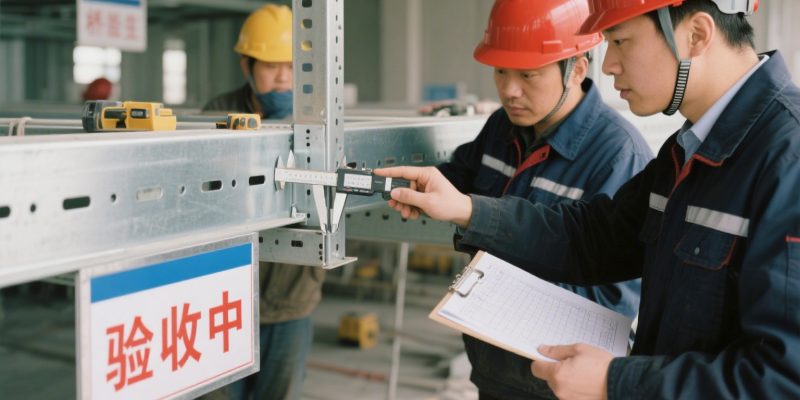
Load Capacity and Structural Integrity in Cable Tray Risk Assessment
Another important aspect of the cable tray risk assessment process is determining the load capacity of the tray system. Cable trays are designed to carry specific loads, and exceeding these limits can result in tray deformation, sagging, or even complete structural failure. Therefore, conducting a cable tray load calculation is crucial to assess the weight of the cables, along with any additional equipment or environmental factors that could impose extra strain on the tray system. This calculation helps ensure that the tray is capable of safely supporting the total load, considering both the immediate and potential future demands.
A proper cable tray risk assessment takes into account the number and type of cables that will be housed within the tray, including their weight, insulation, and power requirements. This helps determine whether the tray is suitable for the load or if a stronger or larger tray is needed. Additionally, the cable tray requirements, such as the required size, material, and environmental conditions (e.g., indoor vs. outdoor, corrosive environments), should be considered to ensure long-term functionality and safety. At GangLong Fiberglass, we offer a variety of cable tray options that can accommodate different loads and meet diverse requirements, from light-duty applications to heavy-duty industrial setups. Our team can assist in performing a detailed load capacity analysis and evaluating the specific requirements of your cable tray system to ensure it’s the best fit for your needs.
The structural integrity of the cable tray itself is another key consideration in the risk assessment. If the tray is not properly secured or mounted, it can become unstable, leading to potential hazards. A risk assessment helps identify any weaknesses in the tray’s installation, such as improperly placed supports or inadequate anchoring. Ensuring the structural integrity of the system is essential to maintaining safety throughout the lifecycle of the installation.
Cable Tray Risk Assessment for Fire and Electrical Hazards
One of the most critical aspects of the cable tray risk assessment is evaluating the risk of fire and electrical hazards. Electrical cables, when improperly managed, can become a significant fire risk due to overheating or exposure to combustible materials. Cable trays must be designed and installed in a way that minimizes these risks. The cable tray risk assessment should evaluate the proximity of the tray to other systems or structures, ensuring that the tray does not block airflow or create heat pockets that could lead to overheating.
A comprehensive risk assessment also considers the potential for electrical faults within the tray system. Electrical faults, such as short circuits or ground faults, can cause significant damage to cables and increase the risk of fire. The risk assessment process will help determine whether the tray system has adequate grounding, insulation, and protection against electrical faults. GangLong Fiberglass cable trays are designed to handle electrical cables safely and are often used in systems where electrical safety is a high priority. Our trays are built to reduce the risk of electrical faults by providing effective cable separation and supporting airflow to prevent overheating.
Using Risk Assessment Data for Improved Installation Planning
The data gathered from a cable tray risk assessment can also be used for improved planning and documentation throughout the installation process. A well-documented risk assessment helps ensure that all potential hazards are identified, and safety measures are put in place to address them. It also serves as a reference for future maintenance or inspections, providing valuable insights into the design and performance of the cable tray system.
For example, if the risk assessment identifies potential corrosion risks due to exposure to chemicals or moisture, this data can be used to select corrosion-resistant materials or adjust the installation layout. Similarly, if the assessment reveals that the system will be exposed to high temperatures, the installation plan can be adjusted to ensure proper cooling and airflow.
At GangLong Fiberglass, we believe in making the cable tray risk assessment process as easy and comprehensive as possible. Our products are fully compliant with international safety standards, and our team is available to assist with risk assessment planning to ensure that your cable tray system is designed for maximum safety and performance.
The Role of Ongoing Risk Assessment and Maintenance
Cable tray systems require ongoing risk assessments to ensure continued safety throughout their lifespan. Over time, environmental conditions, system usage, and wear and tear can introduce new risks that were not present during the initial installation. Regular inspections and assessments help identify any potential issues that may arise, allowing for timely maintenance or upgrades.
By conducting periodic cable tray risk assessments, you can proactively address problems such as cable wear, overheating, or structural degradation before they lead to failures or hazards. GangLong Fiberglass offers maintenance solutions and recommendations for keeping your cable tray systems in top condition, ensuring their continued safety and reliability over time.
The Key of Cable Tray Risk Assessment in Installation and Operation
A cable tray risk assessment ensures system safety and efficiency by identifying hazards in material handling, electrical work, and environmental conditions before and after installation. By mitigating risks—such as lifting injuries, shock, and corrosion—teams protect workers and extend tray lifespan, maintaining reliable, compliant cable management throughout its service life.
Material Handling Hazards
Heavy cable tray material—including steel, aluminum, or fiberglass—require proper lifting and positioning to prevent musculoskeletal injuries. Assess each cable tray material’s weight, rigidity, and equipment adequacy, ensuring hoists, dollies, or lifting tongs are available. Training on manual handling best practices and ergonomic tool usage minimizes strains, dropped loads, and installation delays, promoting both productivity and worker well-being.
Tool Inspection and Training
Power and hand tools—drills, wrenches, and cutters—must undergo regular inspections for electrical safety and mechanical integrity. A risk assessment reviews insulation resistance, guard functionality, and torque settings. Implement scheduled maintenance and repair protocols to address defects. Provide comprehensive training on safe tool operation, proper guard use, and lockout/tagout procedures to prevent tool-related incidents and ensure a secure work environment.
Height-Related Hazards
Elevated work introduces fall and dropped-object risks during cable tray installation. Verify the stability of scaffolds, ladders, and platforms, and install fall protection systems—harnesses, lifelines, and guardrails—correctly. Train personnel in equipment inspection and safe operation. Secure tools and materials with lanyards to prevent drops. Establish rescue procedures and maintain clear zones beneath work areas to protect both installers and bystanders.
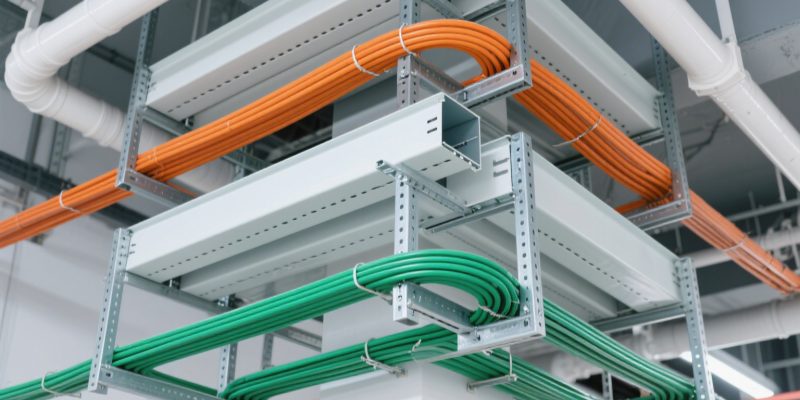
Choosing the Right Grid Cable Tray for Projects
Electrical Hazards and Safety Measures in Cable Tray Risk Assessment
Electrical hazards such as shock, arc flash, static buildup, and overcurrent pose significant risks during cable tray installation and operation. A thorough cable tray risk assessment identifies these dangers and prescribes safety measures—circuit de-energization, PPE, grounding, overcurrent protection, and regular inspections—to safeguard personnel and maintain system integrity.
Environmental Risk Considerations
Assess weather, chemical exposure, and confined-space hazards before installation. In outdoor settings, monitor forecasts to avoid high winds or precipitation. For chemical plants, verify material compatibility with rinse-down procedures and vapors. Ensure proper ventilation and lighting in enclosed areas. Provide weather-resistant PPE—rain gear, thermal layers, or chemical suits—as needed. Incorporate environmental controls into the installation plan and postpone work under unsafe conditions.
Operational Risk Identification and Mitigation
After installation, conduct regular inspections for physical damage, cable overcrowding, and moisture ingress. Check cladding seals, support brackets, and tray alignment. Verify that cable fill ratios and segregation requirements are maintained to prevent overheating and interference. Replace worn or corroded components promptly. Document findings and corrective actions. Schedule predictive maintenance to address potential fatigue or environmental degradation before failures occur.
Static Buildup Prevention
Prevent electrostatic discharge by bonding and grounding all metallic tray components. Use conductive supports or grounding straps to equalize potential differences. In low-humidity or cleanroom environments, maintain humidity above 40% to reduce charge accumulation. Regularly inspect grounding connections for continuity. Install anti-static mats or coatings on trays when handling sensitive electronics. Proper static control protects both personnel and equipment from damage.
Overcurrent Protection Measures
Integrate overcurrent protection by routing power cables through dedicated trays with appropriate segregation. Install branch circuit breakers or fuses sized to cable ampacity. Use current-monitoring devices to detect overloads or faults early. Ensure proper conductor sizing and thermal-rated lugs to prevent overheating. Label tray sections with maximum permissible loads. Coordinate protective settings to minimize cable damage and maintain system integrity in fault conditions.
Multi Line Cable Tray Price Comparison for Projects
Documentation and Reporting in Cable Tray Risk Assessment
Comprehensive documentation of a cable tray risk assessment records identified hazards, their likelihood, potential impacts, and mitigation measures, along with site conditions, tray specifications, environmental factors, and cladding details. This transparent, auditable report supports future projects, regulatory inspections, and ongoing monitoring of control measures and corrective actions.
Ensuring Long-Term Safety
Ongoing cable tray inspection and assessments extend system lifespan by periodically reviewing integrity and adapting to changes. Regular cable tray inspections evaluate support brackets, cladding condition, cable loads, and environmental impacts. Any new installations, reconfigurations, or operational shifts—such as added cables or altered equipment—trigger reassessments to confirm capacity and clearance remain within safe limits. This proactive strategy prevents overloads, corrosion, or physical damage, ensuring sustained performance and compliance over the tray’s service life.
Training and Communication
Effective risk management relies on well-trained personnel who understand hazards, proper installation techniques, and safety protocols. Training programs cover handling methods, use of personal protective equipment, and emergency procedures specific to cable tray systems. Clear communication channels ensure that assessment findings, mitigation plans, and updates reach all stakeholders—installers, maintenance crews, and facility managers. Regular toolbox talks and accessible documentation reinforce responsibilities, promote safety culture, and empower teams to report concerns or suggest improvements.
Continuous Improvement and Review
Adapting to evolving regulations, technologies, and site conditions requires periodic reviews of risk management strategies. Establish a schedule to revisit assessment criteria, update hazard analyses, and incorporate lessons learned from incidents or near-misses. Benchmark procedures against industry best practices and revise protocols when new materials, installation methods, or code amendments emerge. This iterative process fosters innovation, enhances protective measures, and ensures that safety practices remain effective, resilient, and aligned with current regulatory requirements.
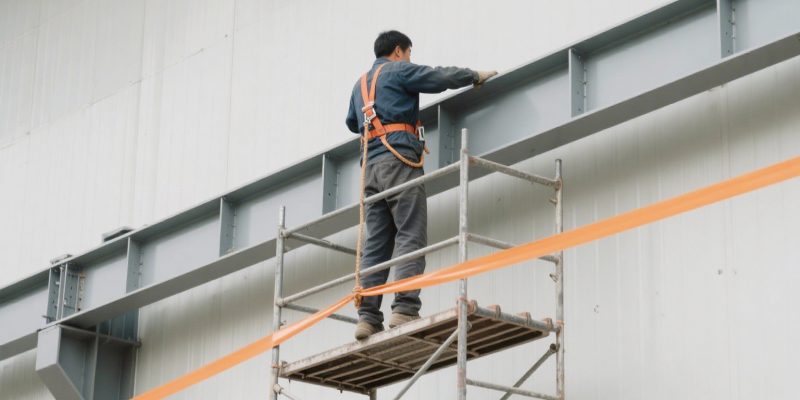
Cable Tray Rubber Price Trends in the Industry
FAQs about Cable Tray Risk Assessment
The installation of cable trays can pose several hazards if proper safety measures are not followed. One significant risk is electrical shock, which can occur if the tray is installed near live electrical circuits or if proper grounding is not maintained. Workers can also face falls, especially when working at heights or using ladders and scaffolding to install trays. Improper lifting techniques can cause musculoskeletal injuries, particularly when handling heavy trays and components. Additionally, there is a risk of cuts, abrasions, or eye injuries when handling sharp edges of metal trays or using tools without adequate protection. Other hazards include exposure to hazardous materials like asbestos or lead in older buildings, and the risk of fire if cables are not installed correctly within the tray, potentially causing overheating. To mitigate these risks, it is crucial to follow industry safety standards, wear appropriate personal protective equipment (PPE), and ensure the installation is carried out by trained professionals.
Cable management, while essential for maintaining organized and efficient electrical systems, can present various hazards if not properly handled. One of the main hazards is the risk of electrical shock, particularly when cables are not securely installed or are left exposed to the elements. If cables are not routed properly or are subject to excessive wear and tear, there is also a risk of electrical shorts, which could lead to fires or other hazards. Physical injuries can occur if cables are improperly pulled, dragged, or positioned in ways that put strain on workers’ muscles or joints. In poorly managed environments, cables can also create tripping hazards, especially in high-traffic areas, which can lead to falls and injuries. Additionally, cables that are not installed with proper ventilation can overheat, leading to potential fire hazards. Proper cable management techniques, including the use of appropriate trays, ties, and insulation, are essential to reducing these risks and ensuring a safe working environment.
Cable pulling is a crucial part of electrical installations but comes with its own set of hazards. The most common hazard is physical strain and injury, particularly musculoskeletal injuries from lifting, pulling, or maneuvering heavy cables. The repetitive motion involved in pulling cables through trays, conduits, or ducts can lead to strain on the back, arms, and shoulders. Additionally, pulling cables through tight spaces or long distances can cause damage to the cables themselves, resulting in electrical faults or failures. Another significant hazard is exposure to live wires, especially if the work is performed near energized circuits, which can lead to electrical shock or even electrocution. Workers may also face eye injuries from sparks or debris when cutting or handling cables. To reduce these risks, workers should use the proper tools and techniques for cable pulling, including cable lubricants to ease the process, wear appropriate personal protective equipment (PPE), and ensure that all power sources are de-energized before starting the work.

As the editor of GangLong Fiberglass, I have years of experience and in-depth research, focusing on cable tray products, fiberglass solutions, and grille systems. I incorporate years of industry insights and practical experience into every content, committed to promoting the progress of the industry. At GangLong Fiberglass, my commitment is reflected in every product, from innovative cable trays to durable fiberglass solutions and sturdy grille systems. As an authoritative voice in the industry, my goal is to provide valuable information to professionals and businesses and promote forward-looking solutions.

